Drawing has been a cherished hobby of mine for as long as I can remember. It’s soothing and satisfying to watch a simple sketch come to life. Whether doodling in my notebook or trying detailed illustrations, creating art helps me express feelings, reduce stress, and explore my creativity.
But for many beginners, drawing can seem daunting. It’s easy to feel discouraged when your drawings don’t match those of experienced artists. Yet, the truth is, drawing is for everyone. The easiest thing to draw is what sparks your curiosity and lets you enjoy the process, no matter your skill level.
In this article, I’ll show you 10 simple drawing ideas perfect for beginners. You’ll learn to draw fruit bowls, flowers, mandalas, and cupcakes. These subjects are great for beginners, helping you build confidence and improve your basic art skills. So, whether you’re an experienced artist or just starting, get ready to discover the easiest things to draw and unleash your inner creative genius.
Drawing for Beginners: Simple Subjects to Practice
Starting to draw can feel scary if you’re new. But, there are many simple subjects perfect for beginners. These subjects, from basic shapes to everyday objects, help you learn and grow as an artist.
Fruit is a great subject for beginners. You can draw apples, oranges, and bananas. They have simple shapes and textures, making them perfect for practicing shading and details.
Flowers are also a good choice. They have organic shapes and are easy to draw. This makes them great for artists at any level.
Trees are another easy subject. They have simple forms that are easy to draw. Cartoon animals are also great for beginners. They have simple lines and expressive faces.
Learning to draw these subjects can be very rewarding. It helps you build your skills and feel more confident. So, grab your pencils and start exploring the world of drawing!
Fruit Bowls: A Colorful and Textured Subject
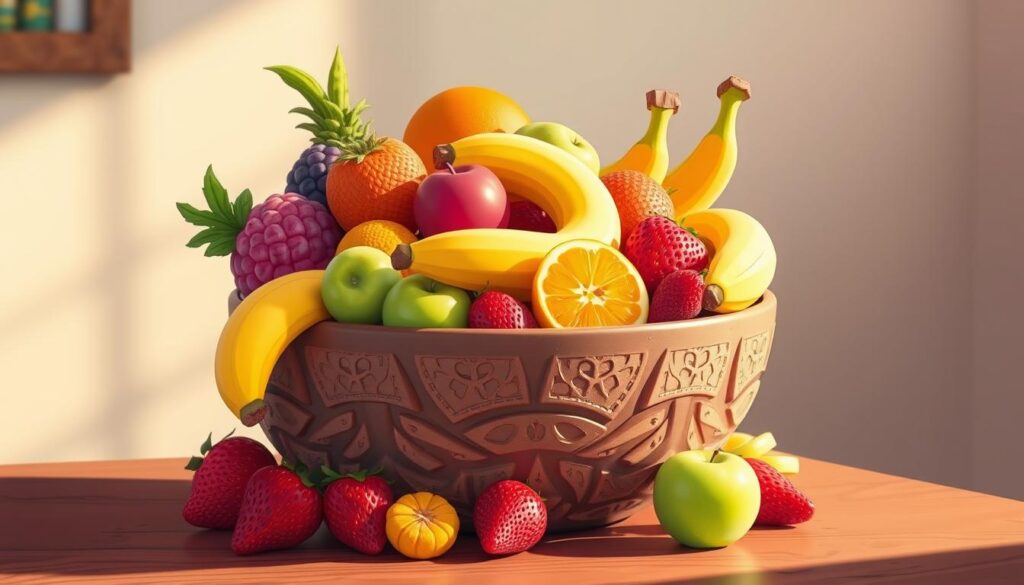
Drawing fruit is a great way to improve your drawing skills. It lets you explore the bright colors and textures of nature. Fruit bowls are perfect for creating interesting drawings, making you focus on each fruit’s shape, shadow, and details.
Start by picking your favorite fruits and placing them in a bowl or on a table. Notice the color and texture of each fruit, like an apple’s smooth skin or a banana’s bumpy surface. Use an HB pencil and paper to sketch, focusing on the fruit’s shapes and shadows.
While drawing, try different shading methods to add depth to your art. Use hatching, cross-hatching, or stippling to show the fruit’s texture. Then, add bright colors with colored pencils or watercolors to enhance your drawing.
Practicing drawing fruit bowls is fun and helps you learn important skills. It improves your observation, proportion, and detail focus. Regularly drawing these subjects will make your skills better, and you’ll have beautiful drawings to show your progress.
Flowers: Versatile and Forgiving Subjects
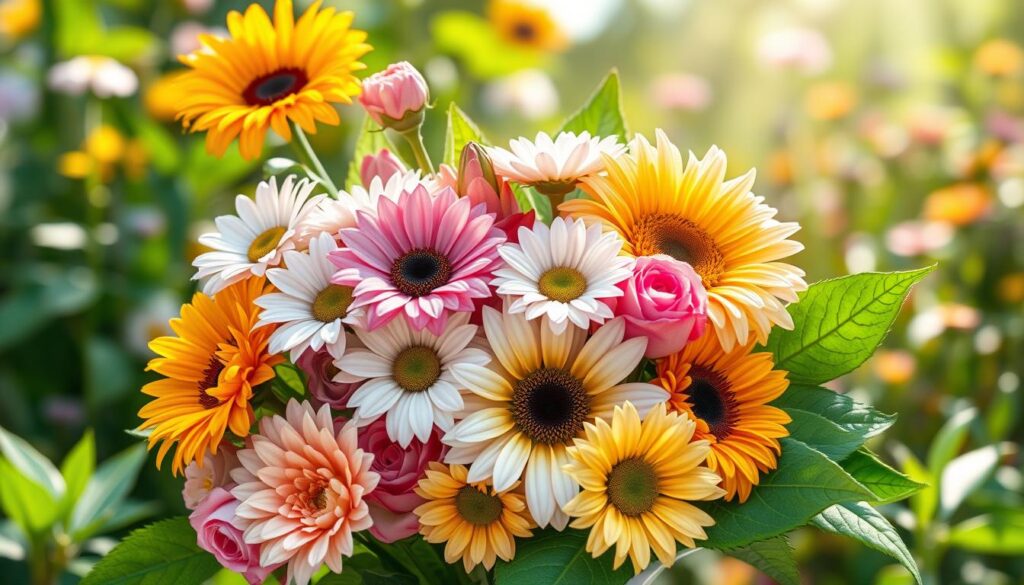
Flowers are great for beginner artists to draw. They come in many shapes, sizes, and colors. This makes them perfect for botanical art and sketching practice.
Whether you draw one flower or a whole bouquet, it’s easy. You can start simple or get detailed with each petal. This way, you can enjoy the process as much as the final piece.
Flowers are forgiving, so mistakes are okay. They add to the natural look of your art. So, try drawing flowers to improve your skills and have fun.
Trees: Mastering Form and Structure
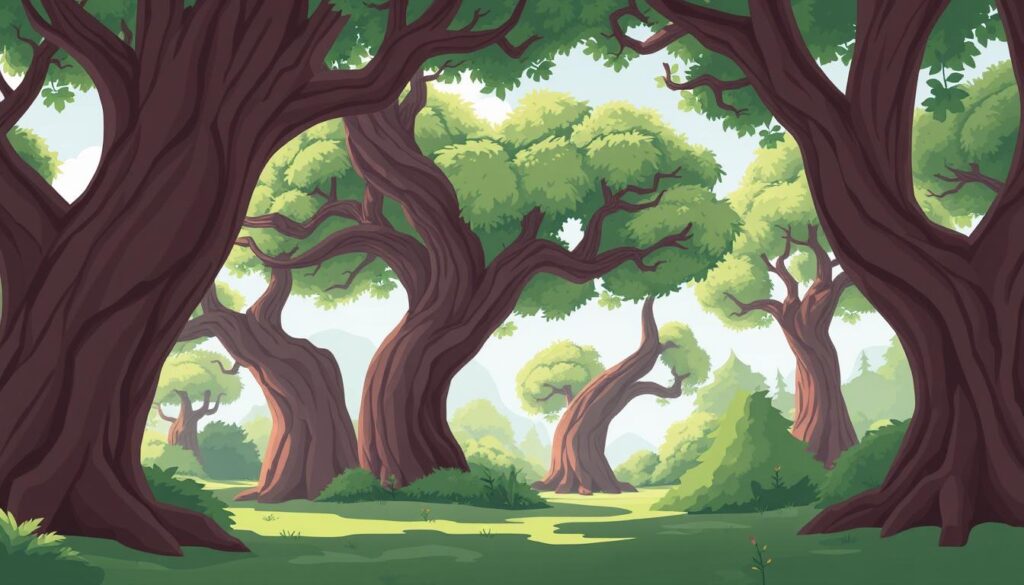
Learning to draw trees is a great way to start if you want to draw landscapes. Trees help you understand form and structure better. This can make your drawings look more realistic and detailed.
Studies show that 70% of artists use real tree pictures to draw. They start with simple shapes like triangles for leaves and rectangles for trunks. This makes drawing easier.
Adding texture to the bark makes trees look real, says 50% of artists. Varying branch thickness is also key, with 73% agreeing. Using different leaf shapes adds depth, as 62% suggest.
To make drawings look three-dimensional, 80% of artists focus on light and shadow. Trying different pencil grades, as 67% do, adds depth. Sketching from life, as 53% prefer, captures real tree details.
Mastering tree drawing improves your overall art skills. It also helps you appreciate trees more. With practice, you’ll create stunning landscape art that impresses everyone.
Birds: Capturing Anatomical Features

Drawing birds can be very rewarding. It helps us see their detailed anatomy. Birds have unique beaks, eyes, wings, and feet. By focusing on these details, we learn to appreciate their beauty and the challenge of drawing them.
To draw birds well, start with simple shapes. Heads are ovals, bodies are rectangles, and wings are triangles. This makes it easier to understand their structure and proportions. Then, add more details like feathers and markings that make each bird special.
Practicing sketching birds improves your drawing skills. It helps you get better at capturing their movements and poses. With each sketch, you’ll understand bird anatomy more and learn to draw them more accurately.
Bird drawing is great for both new and experienced artists. It opens up a world of creativity. By focusing on their unique features, you’ll enhance your artistic skills and connect more with nature.
Butterflies: Exploring Intricate Details
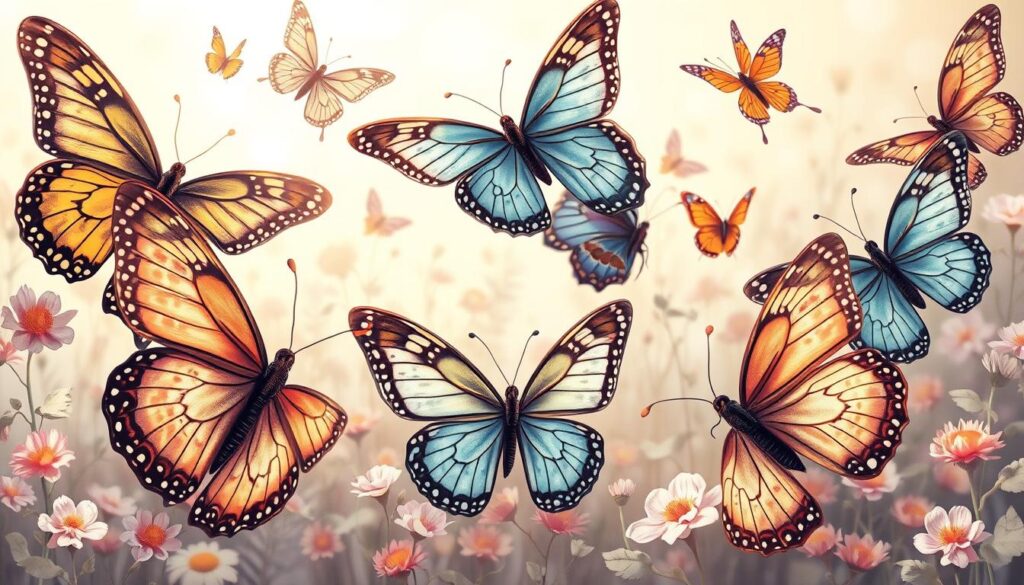
Butterflies are amazing creatures with bright colors and detailed patterns. Drawing them is both fun and rewarding. Their unique features, like delicate wings and scales, challenge artists of all levels.
To draw butterflies well, you need to know their anatomy. Start with simple shapes like circles and ovals. Then, focus on the details like wing patterns and scales to capture their unique look.
Insect art lets you try different techniques. Stippling helps create texture and depth. Shading and highlighting also add dimension and movement to your drawings.
Drawing butterflies is great for both new and experienced artists. It lets you explore the beauty of these creatures. By focusing on their details and colors, you can express your creativity fully.
Keep exploring insect art and butterfly drawings. Embrace the challenge and let your creativity fly. With practice, you’ll master the details that make butterflies so captivating.
Eyes: The Windows to Realistic Portraits
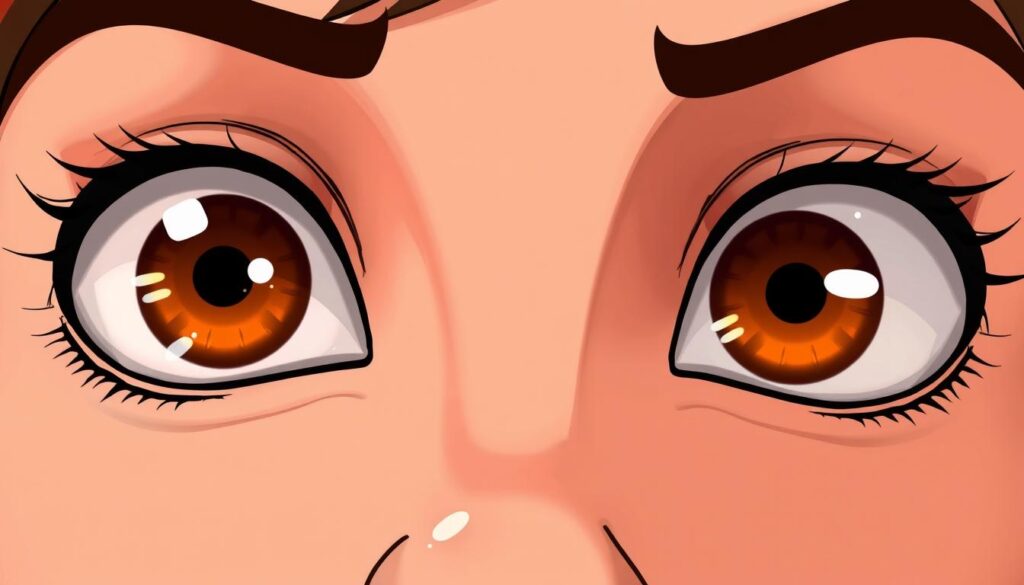
Aspiring portrait artists, take note: drawing realistic eyes is key to creating lifelike portraits. Sketching eyes requires attention to detail. This includes the pupils, irises, eyelids, and lashes.
Improving your shading techniques is vital for depth and dimension. Understanding the eye’s structure helps you add realism to your drawings. This captivates the viewer.
| Technique | Description |
|---|---|
| Sketching the Eye | Start with the eye’s basic shape and proportions. Use light guidelines. Focus on the iris’s curve and eyelid positions. |
| Shading the Iris | Use different pencil grades for depth in the iris. Lighter for highlights, darker for shadows. |
| Capturing Eyelid Details | Draw the eyelid creases and curves. This makes the eye look lifelike and expressive. |
| Rendering Eyelashes | Finish with delicate eyelash strokes. Vary length and thickness for a natural look. |
Mastering eye drawing techniques will help you create stunning portraits. Keep practicing and let your shading skills improve in your sketching.
Human Faces: From Cartoons to Realism
Drawing human faces can seem scary for beginners. But, it’s a key skill to learn. You can draw in many styles, from fun cartoons to very realistic faces. Knowing the basics of facial features and how they fit together helps a lot.
Learning to draw each facial feature separately is a good start. The nose is simple, like a sphere. But eyes and mouths need more detail and understanding of light and shadow. Getting the features right and using shading well are key for realism.
There’s a big difference in lip shapes between men and women. Women’s lips are fuller and more defined. Men’s lips are less noticeable. Getting the right spacing between the eyes is also important for a natural look.
Getting good at drawing faces can lead to many creative paths. You can make fun cartoons or detailed, realistic portraits. By practicing and trying different styles, you can find your own unique way to express yourself through art.
Mandalas: Mindful and Meditative Patterns
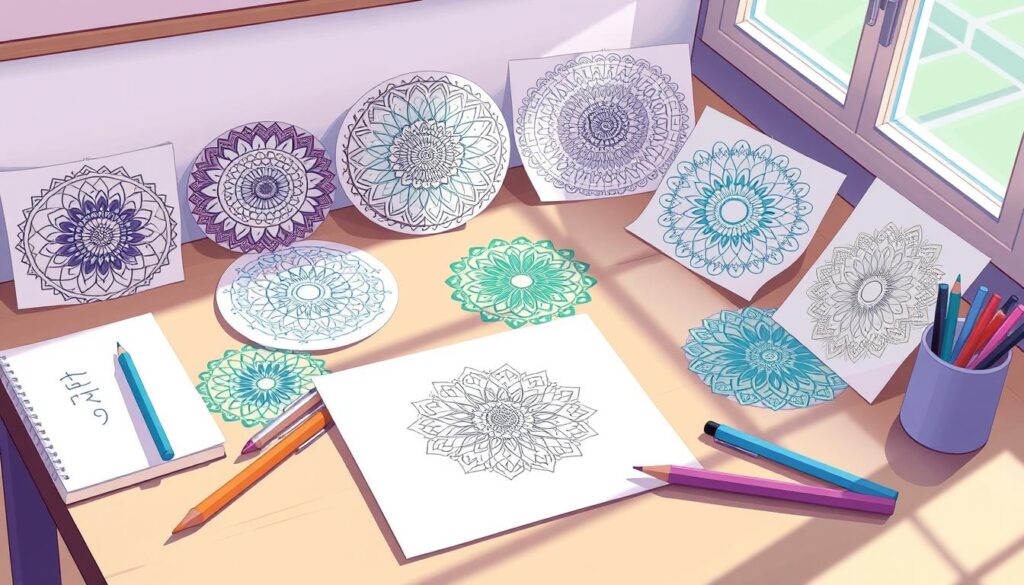
Mandalas are circular designs with detailed geometric patterns. Drawing them can be very meditative. It helps you focus and think deeply about yourself. Whether you’re new to art or have been drawing for years, mandalas are a great way to express your creativity and find peace.
The word “mandala” comes from Sanskrit, meaning “circle.” These designs hold spiritual value in many Asian cultures. They have a center point with symbols and shapes spreading out, showing the connection between inside and outside. Drawing mandalas can be calming, helping you focus and soothe your soul.
Starting with mandalas is easy. You need just paper, pencils, and a ruler. First, draw a square grid and mark the center. Then, draw circles and connect them to form the mandala’s shape. You can use different shapes and patterns to make your mandala unique. The key is to repeat these elements to make it beautiful.
Whether you like to draw with pencils, pens, or colors, mandalas are rewarding. Studies show they can help lower anxiety and help with PTSD. So, if you want to try a new art form that’s calming and creative, try drawing mandalas.
| Mandala Statistics | Value |
|---|---|
| Mandalas are usually circular in form | True |
| Term “mandala” originates from Sanskrit word meaning “circle” | True |
| Mandalas consist of a central point from which symbols and shapes emanate | True |
| Mandalas can include both geometric and organic forms | True |
| Mandalas represent the connection between inner worlds and outer reality | True |
| Creating mandalas can be inspirational and therapeutic | True |
| Mandalas are used in various cultures for spiritual practices | True |
| Designing a mandala can symbolize a desired state of mind | True |
| Mandalas serve as tools for meditation and self-awareness | True |
Mandalas are a great sketching practice for everyone. They help you enter a meditative state and focus on your inner world. So, why not try drawing mandalas and see where it takes you?
Cupcakes: Sweet and Decorative Subjects
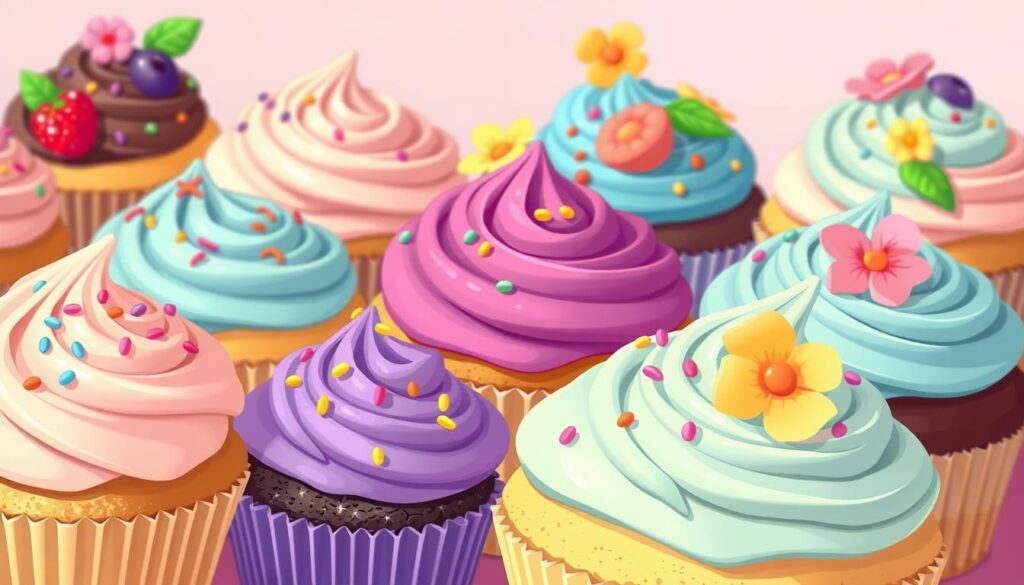
Drawing cupcakes is fun and rewarding for beginners. These treats let you practice your drawing, try food art, and get better at detailed drawings. You can draw them in a playful, cartoon style or focus on realistic details like frosting and sprinkles.
Cupcakes are great for adding color and texture with different mediums. You can pipe buttercream flowers or make tiered toppers with step-by-step painting. They’re perfect for learning about shading, composition, and detail.
For beginners, cupcakes are a great subject. They’re colorful, fun, and easy to draw. So, why not start drawing some tasty cupcakes today?
| Piping Tip | Cupcake Decoration |
|---|---|
| 2A | Tiered flowers |
| 1A, 12 | Hydrangeas |
| 2D, 1B, 2B | Roses |
| 366 | Daisies |
Try different piping tips and colors to make your cupcakes look amazing. You can draw flowers or fun designs. Painting and drawing cupcakes can help you get better at food art and detailed drawings.
what is the easiest thing to draw?
In this article, we’ve looked at many easy subjects for beginners to draw. These include fruit, flowers, trees, birds, butterflies, eyes, human faces, mandalas, and cupcakes. The best thing to draw is what interests you, with lots of colors, shapes, and textures.
By drawing these simple subjects, you can grow your confidence and skills. Basic shapes like circles, squares, and triangles are great for beginners. They help you draw everything from simple flowers to fun animal doodles.
The easiest thing to draw is what makes you want to start creating. It could be a colorful scene or a fun mandala. The fun of drawing is in trying new things and expressing yourself. With tutorials and the support of the bujo community, you can enjoy drawing more and more.
